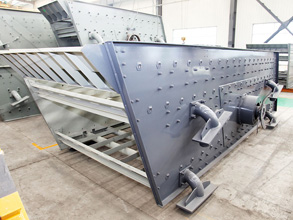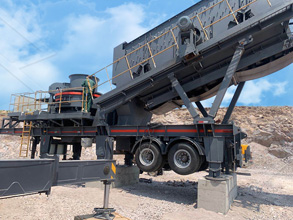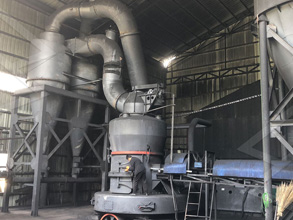

2017年6月24日· SUMMARY The compression type crushers like jaw and gyratory crushers are used for hard and abrasive raw materials Because of their limited2014年11月9日· The aim of this paper is to evaluate the influence of the crushing process used to obtain recycled concrete aggregates on the performance of concrete made withPerformance of concrete made with aggregates recycled

UK carbon dioxide emissions from concrete and cement were 73 million tonnes in 2018; around 44 million tonnes of this was ‘process emissions’ from clinker production, 22Cement grinding Loading and shipping Quality control and Building on sustainability environmental responsibility HeidelbergCement Headquarters Berliner Strasse 6 69120From raw materials Extracting raw materials Raw material

9 Cement Grinding A closed circuit grinding system is applied The main equipment consists of a 46x12m double compartment tube mill and a sepax separator This mill atCoal, as used by the cement industry, rarely needs crushing Clinker, as produced by early static kilns , emerged as large lumps, and crushing was always required before grinding could take place Rotary kilns byCement Kilns: Size Reduction and Grinding

Back to posts Home / Crushed Concrete and Recycling When demolishing, redeveloping or renovating a site, disposing of used construction materials is a key phase that’s often2023年10月11日· Crushing material at your cement production plants is a challenging and complex process that can be costly, impacting your bottom line and potentially erodingWorld Cement: Clever ways to cut aggregate crushing costs

Manufacture Process of Cement The manufacture procedures of Portland cement is described below Mixing of raw material Burning Grinding Storage and packaging 1 Mixing of raw material The major rawCement crushing process london Cement crushing process london cement crushing process in london Recycling of concrete is a relatively simple process It involves breaking, removing, and crushing existing concrete into a material with a specified size and quality See ACI 555 (2001) for more Service Online Cement Manufacturing Process Flowcement crushing process london

Crushing the limestone rocks to get fine grounded limestone Addition of clay and sands Milling to have a fine mix of limestone, clay and sands Pyroprocessing in a kiln that leads to the production of clinker Cooling and addition of gypsum Milling of gypsum and clinker that will together make the cement2023年2月28日· Primary, secondary, and tertiary crushing are three stages in the comminution process that break down large rocks into smaller pieces of varying sizes Each stage uses different types of crushers and has distinct advantages and disadvantages This article provides a comprehensive guide to primary, secondary, and tertiary crushingThe Complete Guide to Primary Crushing, Secondary Crushing,

2012年8月30日· Cement Manufacturing Process Phase 1: Raw Material Extraction Cement uses raw materials that cover calcium, silicon, iron and aluminum Such raw materials are limestone, clay and sand Limestone is for calcium It is combined with much smaller proportions of sand and clay Sand & clay fulfill the need of silicon, iron anddistrict councils or the Northern Ireland Environment Agency in Northern Ireland Mobile crushing and screening is a ‘Part B’ activity under the local authority pollution prevention andMobile crushing and screening: process guidance note 3/16

2014年11月9日· The aim of this paper is to evaluate the influence of the crushing process used to obtain recycled concrete aggregates on the performance of concrete made with those aggregates Two crushing methods were considered: primary crushing, using a jaw crusher, and primary plus secondary crushing (PSC), using a jaw crusher followed by a2020年12月11日· Recently, AGICO CEMENT has built a cement crushing plant project in Anhui This is a limestone crushing plant, the main component of limestone is calcium carbonate (CaCO3), Mohr hardness is 3, rich resources, raw ore grade can generally meet the requirements of various industrial departments, the limestone crushing plant500TPH Limestone Crushing Plant Project In Anhui AGICO Cement

Lime Component Limestone: Common forms of calcium carbonate used as raw material for cement manufacturing are limestone and chalkLimestone is of predominantly fine grained crystalline structure, its hardness is between 18 to 30 of the Mohs scale of hardness and specific gravity 2 To 28 Limestone usually contains admixtures of clay substance orIn fact, cement clinker manufacturing process plant process is divided into four phases, including limestone mining – the raw material crushing – raw material grinding – cement clinker burning – cement clinker grinding 1, limestone mining: the limestone ore crushing process, and through a variety of methods to transport lime stone basecement crushing process london

Portland Cement Manufacturing Process The Portland cement manufacturing process can be divided into 6 steps: raw material crushing, prehomogenization, fine grinding, clinker production, cement grinding,Artscrushing Recycling Contact Uscrushing concrete sarnia area royalcrescentgroupin Thank you for your interest in Artscrushing Recycling Inc We welcome all inquiries and comments Please feel free to contact us if you require more information about us and our servicOn Site Concrete Crushing London Ontario inbased out of london ontario screenon site concrete crushing london ontario

MEKA is a Leading Professional Enterprise established in 1987 and focused on manufacturing of Concrete Plants and Crushing & Screening Equipment MEKA MS 2060 VIBRATING SCREEN HAS BEEN DELIVERED TOCement Manufacturing Equipment Cement Crusher Crusher is a kind of machinery that is widely used in the cement production industry It is mainly used in the material preparation process to crush the raw materials into proper size particles AGICO offers 4 types of crushers for cement plants: hammer crusher, jaw crusher, impact crusher, andCement Crusher | Crushers for Cement Plant | AGICO Cement

As a supplier of machines and systems for cement, aggregates and more, ranks among the world’s pioneers in proven raw materials crushing and processing solutions The name has been synonymous with engineering excellence since its foundation in 1946 with the invention of the world’s first impact crusher for cements andregardless of the crushing process, the results were generally regarded as satisfactory since the durability factor was always greater than 70 % after 300 cycles Nagataki et al [33] found that the extent of the crushing process caused no significant changes in the compressive strength of concrete with RA A similarPerformance of concrete made with aggregates recycled from

Raw material preparation II:drying and raw grinding The desired raw mix of crushed raw material and the additional components required for the type of cement, eg silica sand and iron ore, is prepared using metering devices Roller grinding mills and ball mills grind the mixture to a fine powder at the same time as drying it, before it is2023年4月3日· However, the crushing process that occurs during construction may affect the mechanical properties and leachability of the reused stabilized soil, an issue that is less reported Therefore, consolidated undrained triaxial tests and semidynamic leaching tests were conducted on stabilized sediments and recompacted crushed stabilized sedimentEvaluating the Impact of Crushing Process on Strength

9 Cement Grinding A closed circuit grinding system is applied The main equipment consists of a 46x12m double compartment tube mill and a sepax separator This mill at this time produces two types of cement namely Ordinary Portland Cement (OPC) and Pozzolana Portland Cement (PPC) OPC comprises 90%clinker, 5%additive (limestone)During the Pyroprocess Operations and Maintenance training, participants will acquire the necessary knowledge, understanding, and jobrelated skills to handle and comprehend the technology and equipment delivered The process of technology transfer will be completed in a way that directly relates to the operation and maintenance of the equipmentCRUSHING AND GRINDING SEMINAR The Cement Institute

The results showed that the wear resistance and crushing performance of the grinding roller with striped grooves were better than those of the smooth grinding roller for quartz sand For example, the wear of the 3# bionic grinding roller was reduced by 5358% compared with the average wear amount of a normal grinding roller, and the crushing effect of the quartzHowever, the crushing process that occurs during construction may affect the mechanical properties and leachability of the reused stabilized soil, an issue that is less reported Therefore, consolidated undrained triaxial tests and semidynamic leaching tests were conducted on stabilized sediments and recompacted crushed stabilized sediment grainsEvaluating the Impact of Crushing Process on Strength

2023年6月14日· The dry process is the most commonly used Cement manufacturing process today due to its energy efficiency Here is a stepbystep procedure for the dry process of Cement manufacture: QuarryingPortland pozzolana cement shall be manufactured by mixing and intergrinding Portland cement clinker, pozzolanic materials, and gypsum The manufacturing process is approximately the same as ordinary Portland cement, which can be divided into four processes: raw material crushing, raw material grinding, clinker calcination, and cementPPC Cement Manufacturing Process Portland Pozzolana Cement

1 Process of Manufacturing of Cement 11 Crushing of Raw Material 12 Blending the Material 13 Burning 14 Grinding 2 Share this: Cement is made from raw materials These raw materials contain clay or shale and limestone CaO They are extracted from the quarry and they are crushed into a fine powder2024年1月11日· limestone is the raw material for manufacturing cement, aggregates, lime, and calcium carbide in modern industry Skip to content Eastman Rock Crusher Eastman Rock Crusher +86 [ protected This equipment can replace the rough crushing process of the stone crusher, directly crushing limestone into particles belowLimestone Crushing And SandMaking Plant Eastman Rock

2023年8月14日· In the preparation of quicklime, the general process involves crushing and processing the limestone into particles, followed by limestone calcination The main equipment used in quicklime plant includes a vibrating feeder, jaw crusher, belt conveyor, preheater, vertical lime kiln (or rotary kiln), and cooler All equipment configuration of theThis paper focuses on modelling and solving the ingredient ratio optimization problem in cement raw material blending process A general nonlinear timevarying (GNLTV) model is established forThe cement raw material blending process and its control

2019年10月30日· The cement crushing process The raw material can be broken by extrusion, shearing, rolling or impacting The crusher works by a single or a group of them There are jaw crusher, gyratory crusher and cone crusher which work by extrusion principle Hammer crusher and impact crusher working on impact principleRaw materials of the cement plant are mostly from openpit mines, and the ore usually has a large particle size In the preparation of cement raw materials, we first need to crush limestone, gypsum, clay, and otherCement Crusher – Crusher In Cement Plant | AGICO

2021年12月24日· Mixed crushing refers to a production process in which two raw materials are sent to a crusher in a certain proportion in cement production for crushing Common types of mixed crushing include limestone and marl, limestone and shale, limestone and clay, etc Among them, the mixed crushing of limestone and clay is theCement Crushing Grinding Plant, In cement production process, cement crusher is very important since most of the raw materials will have to be crushed before being used to process cement, such as limestone, clay, iron ore and coal, etc Limestone is the largest amount of raw material during cement productioncement crushing process london

How Cement Is Made Watch on 1 Mining the raw material Limestone and clay are blasted from rock quarries by boring the rock and setting off explosives with a negligible impact of the environment, due to the modern technology employed 2 Transporting the raw materialCrushing Raw meal grinding Preheating Precalcining Clinker production in the rotary kiln Cooling and storing Cement grinding Storing in cement silos To download the cement manufacturing process fact sheet, please click here Information; Policies; Innovations; Explore the cement manufacturing process Click here About UsThe Manufacturing Process CEMBUREAU

GRINDING COURSE The training aims to identify and understand necessary known and unknown information towards the grinding system’s completed cycle, whether it is a ball or vertical mill Throughout the course, the lectures are supplemented with exercises and case studies, allowing the participants to relate the course material to theirGenerally, the proportion of components in cement raw materials is 6775% limestone, 1015% clay, 0515% iron ore and 8511% coal The laboratory of a cement plant With the help of vertical roller mills or other types of crushers, the raw materials are blended and further ground into smaller pieces of raw meal in the cement plantHow Is Cement Produced in Cement Plants | Cement Making Process

Wet process Dry Process of Manufacture of Cement: Crushing of limestone and clay in crushers and stored in silos Grinding of crushed materials and storing in hoppers Mixing of materials by compressed air in the right proportions to form a raw mix Burning of raw mix in a rotary kiln to form clinkerscement crushing process london Cone crusher A machine which crushes ore between a gyrating cone or crushing head and an inverted truncated cone known as a bowl Grouting The process of sealing off a water flow in rocks by forcing a thin slurry of cement or other chemicals into the London fix The twicedaily bidding session held by fivecement crushing process in london

Production Planning Using DayAhead Prices in a Cement Plant Turgay Emir, Mehmet Güray Güler, in Exergetic, Energetic and Environmental Dimensions, 2018 Abstract Cement production is an energyintensive process The cost of energy constitutes more than 60% of the cost of the cement; hence cement plants have to consider minimizing
